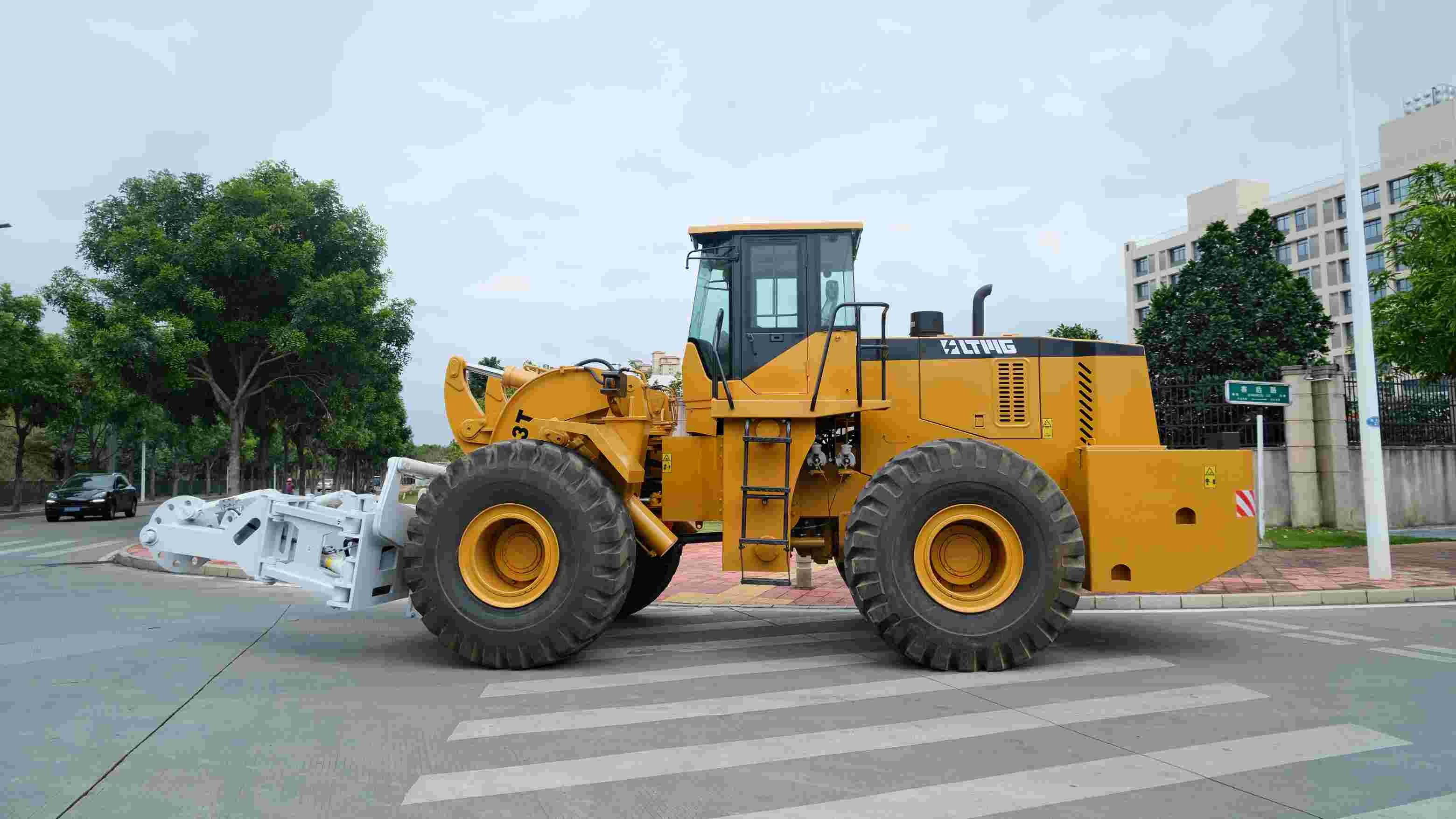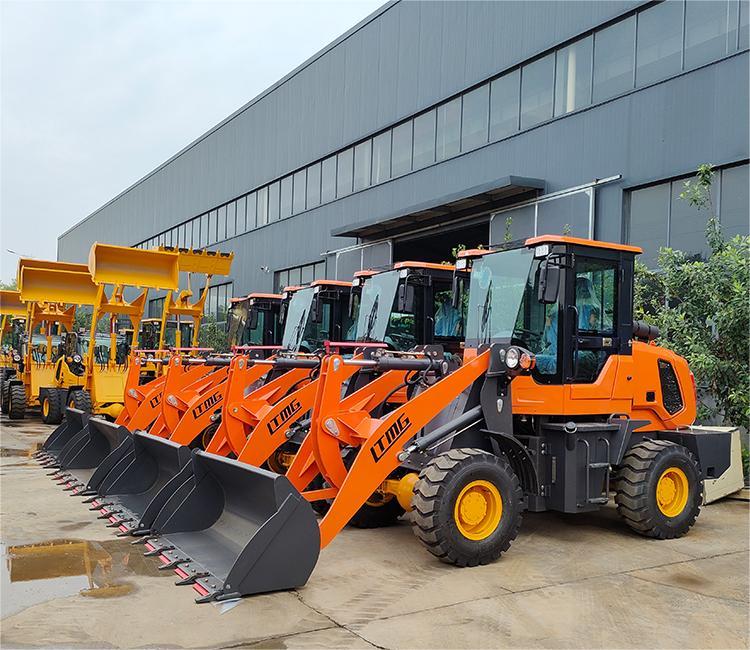Carregadeira de empilhadeira: recursos, vantagens e aplicações
Dec 31, 2024
As empilhadeiras, também conhecidas como empilhadeiras pesadas, são amplamente utilizadas em operações industriais e de armazenamento para manuseio de materiais, empilhamento e tarefas de carga/descarga. Particularmente em canteiros de obras, armazéns e centros logísticos, as empilhadeiras desempenham um papel crucial na melhoria da eficiência do trabalho e na garantia da segurança. Neste artigo, exploraremos as principais funções, principais vantagens e aplicações práticas das empilhadeiras, ajudando você a compreender melhor a importância deste equipamento nas operações diárias.O que é uma empilhadeira?Como o nome sugere, uma empilhadeira é um tipo de equipamento pesado que combina as funções de uma empilhadeira com as de uma carregadeira, normalmente equipada com um acessório como garfos, caçamba ou outros acessórios para movimentação de materiais. Em comparação com as empilhadeiras tradicionais, as empilhadeiras carregadeiras têm maior capacidade de carga e estão equipadas com capacidades off-road superiores, tornando-as altamente eficientes para tarefas de manuseio de materiais em terrenos acidentados e irregulares.Uma empilhadeira é composta principalmente por um motor diesel, chassi, sistema hidráulico e vários acessórios de trabalho (como garfos, caçambas, etc.). Sua operação flexível o torna adequado para uma ampla gama de aplicações, principalmente em indústrias que exigem máquinas versáteis e de alta capacidade. Principais funções de uma empilhadeiraAs empilhadeiras normalmente atendem às seguintes funções essenciais:Manuseio de materiais: A função principal de uma empilhadeira é transportar materiais. Quer se trate de materiais de construção pesados ou itens de armazém menores, as empilhadeiras são capazes de carregar, descarregar e transportar mercadorias com eficiência. Com sua alta capacidade de carga, as empilhadeiras podem manusear materiais que variam de algumas toneladas a dezenas de toneladas.Empilhamento: As empilhadeiras podem ser equipadas com garfos que permitem um empilhamento eficiente de mercadorias. Esta função é particularmente útil em ambientes de armazenamento de alta densidade ou ao empilhar materiais pesados. As empilhadeiras são ideais para tarefas que exigem empilhamento de mercadorias em alturas significativas.Capacidade fora de estrada: Ao contrário das empilhadeiras tradicionais, as empilhadeiras têm um desempenho excepcionalmente bom em condições off-road. Seu forte sistema de acionamento permite que eles naveguem em superfícies irregulares e não pavimentadas, tornando-os adequados para trabalhar em áreas como canteiros de obras, minas e florestas, onde empilhadeiras convencionais podem ter dificuldades.Versatilidade: As empilhadeiras não se limitam apenas ao manuseio de materiais. Ao trocar acessórios como garfos, caçambas ou garras, essas máquinas podem realizar uma variedade de tarefas. Esta flexibilidade permite que sejam utilizados em diferentes indústrias e aplicações, desde a construção à agricultura. Vantagens das empilhadeirasAs empilhadeiras oferecem diversas vantagens distintas, o que as tornam uma escolha popular nos mercados de equipamentos pesados. Aqui estão os principais benefícios:Alta capacidade de carga: As empilhadeiras são normalmente movidas por motores a diesel de alto rendimento e apresentam um chassi robusto e um sistema hidráulico, permitindo-lhes lidar com cargas pesadas. A sua capacidade de carga varia frequentemente entre várias toneladas e mais de 10 toneladas, permitindo-lhes realizar tarefas exigentes com facilidade.Estabilidade: O design robusto das empilhadeiras garante estabilidade superior ao levantar e transportar materiais pesados. Mesmo em terrenos acidentados ou durante operações de carga elevada, as empilhadeiras mantêm um centro de gravidade baixo, evitando tombamento e proporcionando um ambiente de trabalho estável para os operadores.Adaptabilidade a vários ambientes: Uma das maiores vantagens das empilhadeiras é a sua adaptabilidade. Seja operando em pisos lisos de armazéns ou em locais de construção robustos, as empilhadeiras são projetadas para funcionar em diversas condições. Suas capacidades off-road e pneus duráveis permitem que funcionem de maneira eficaz em ambientes que exigem máquinas pesadas.Maior eficiência: As empilhadeiras melhoram significativamente a eficiência do trabalho, permitindo carga, descarga e transporte de materiais mais rápidos. Seus poderosos sistemas hidráulicos e flexibilidade operacional fazem deles uma solução que economiza tempo para tarefas que, de outra forma, exigiriam múltiplas máquinas ou trabalho manual extenso.Custos operacionais mais baixos: As empilhadeiras movidas a diesel tendem a ter custos de combustível mais baixos em comparação com outros tipos de combustível, e seus motores são otimizados para trabalhos de alto desempenho em ambientes difíceis. Isto torna as empilhadeiras econômicas a longo prazo, com manutenção mínima e alta eficiência de combustível.Aplicações de empilhadeirasAs empilhadeiras são usadas em uma ampla variedade de indústrias, cada uma delas se beneficiando das diversas capacidades da máquina. Abaixo estão algumas aplicações principais de carregadeiras de empilhadeiras:Canteiros de obras: As empilhadeiras são comumente usadas em canteiros de obras para transportar materiais de construção como cimento, aço, tijolos e blocos de concreto. Suas altas capacidades de elevação e capacidades off-road os tornam ideais para movimentar materiais pesados e trabalhar em terrenos difíceis.Mineração e Pedreiras: Nas operações de mineração e pedreiras, as empilhadeiras são utilizadas para o transporte de minérios pesados, minerais e rochas. Sua capacidade de carga e desempenho em terrenos acidentados e irregulares os tornam indispensáveis nessas indústrias.Armazenagem e Logística: As empilhadeiras são amplamente utilizadas em armazéns e centros logísticos para tarefas como carga/descarga de contêineres e empilhamento de mercadorias. A sua flexibilidade nos acessórios e as elevadas alturas de elevação tornam-nos adequados para diversas tarefas de movimentação de materiais nestes ambientes.Agricultura e Paisagismo: Na agricultura e no paisagismo, as empilhadeiras são usadas para transportar solo, fertilizantes, colheitas e outros itens pesados. Os seus acessórios versáteis e a capacidade de trabalhar em terrenos rurais e irregulares tornam-nos ativos valiosos nestes campos.Portos e Terminais: As empilhadeiras também são utilizadas em portos e terminais para movimentação de contêineres, empilhamento e operações de carga/descarga. A sua capacidade de manobra em espaços apertados e de manusear contentores grandes e pesados torna-os essenciais nas operações portuárias. Como escolher a empilhadeira certaAo selecionar uma empilhadeira para o seu negócio, vários fatores devem ser considerados para garantir que a máquina seja adequada às suas necessidades específicas:Capacidade de carga: A capacidade de carga de uma empilhadeira é um fator crítico. Dependendo do peso dos materiais movimentados, deve-se escolher uma empilhadeira com capacidade de carga adequada. As empilhadeiras normalmente variam de 3 a 20 toneladas, portanto, é essencial selecionar o modelo certo para sua operação.Ambiente Operacional: O ambiente em que a empilhadeira será utilizada desempenha um papel significativo no processo de seleção. Se você estiver trabalhando em um armazém interno e tranquilo, uma empilhadeira padrão pode ser suficiente. No entanto, se a sua operação envolver terrenos acidentados ou locais de construção, um modelo com capacidades off-road aprimoradas seria mais adequado.Eficiência: As empilhadeiras variam em termos de eficiência operacional. Escolha um modelo que ofereça o melhor equilíbrio entre velocidade, potência e economia de combustível para suas tarefas. Maior eficiência reduzirá os custos operacionais e aumentará a produtividade.Tipo de combustível: Embora nosso foco esteja nas empilhadeiras movidas a diesel, é essencial observar que a eficiência do combustível pode afetar os custos operacionais gerais. Os motores diesel são ideais para ambientes de alta carga, pois oferecem excelente economia de combustível e são projetados para trabalhos intensivos.Recursos de segurança: A segurança é fundamental ao selecionar uma empilhadeira. Procure recursos como sistemas de controle de estabilidade, cabines ergonômicas e áreas de alta visibilidade para garantir a segurança dos operadores. As empilhadeiras também devem cumprir os padrões de segurança da indústria para minimizar o risco de acidentes. As empilhadeiras são máquinas versáteis e de alto desempenho que se tornaram indispensáveis em setores como construção, mineração, armazenamento e logística. Sua capacidade de lidar com cargas pesadas, operar em terrenos acidentados e executar diversas tarefas os torna ativos valiosos para empresas que buscam melhorar a eficiência operacional e reduzir custos. Ao escolher a empilhadeira certa para o seu negócio, você pode otimizar a produtividade, garantir a segurança e obter economias de longo prazo nos custos operacionais. À medida que a tecnologia continua a avançar, podemos esperar funcionalidades ainda mais inovadoras nos futuros modelos de empilhadores, melhorando ainda mais as suas capacidades e desempenho em diversos ambientes de trabalho.

